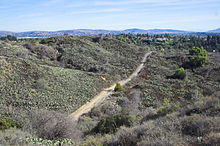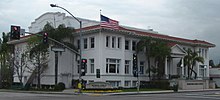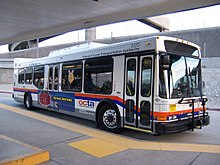Fullerton, California
Historically it was a center of agriculture, notably groves of Valencia oranges and other citrus crops; petroleum extraction; transportation; and manufacturing.Evidence of prehistoric animal habitation, such as saber-toothed cats and mammoths, is present in Ralph B. Clark Regional Park in the northwest of the city.From the description recorded in the diary of Father Juan Crespi, it seems likely that the party camped on July 29 near present-day Laguna Lake, in the Sunny Hills area.Fullerton was incorporated in 1904,[13] Drilling for petroleum began in 1880 with the discovery of the Brea-Olinda Oil Field and fueled the first real boom, peaking in the 1920s.Meanwhile, the city banned all overnight street parking in 1924 – a law enforced to the present day, unless an area is specifically exempted.Although Fullerton, like other Southern California cities, had experienced an expansion of population due to housing development, this increased by an order of magnitude during the post war years.By the late 20th century the city had lost much of its rural character in favor of suburban housing tracts and shopping centers.In the 1990s, the downtown commercial district had become economically depressed, and was known mainly for being an area of sleepy antique stores and small shops.A symbol of downtown's problems was the Fox Theatre, a local landmark which had fallen into disrepair partially due to a fire.During this same period, downtown Fullerton (DTF), especially in the south of Commonwealth area (SOCO),[17] has become more of a busy entertainment district, described by the OC Weekly as "Bourbon Street West."The 293-acre (1.19 km2) Hughes Aircraft Company's Ground Systems Group campus in western Fullerton was redeveloped into a new residential and commercial district called Amerige Heights, in between 2001 and 2004.The city has a mean elevation of 150 feet (46 m) and lies approximately 11 miles (18 km) northeast of the Pacific Ocean straight-line distance.The flat downtown area is laid out in a grid plan centered at the intersection of Harbor Boulevard and Commonwealth Avenue.After recent renewal and beautification projects, it has attracted specialty stores, coffee shops, and restaurants, and has uncharacteristically retained much of its downtown character.Southeastern Fullerton is historically the industrial sector, and is home to small manufacturing, particularly east of Raymond Street and south of Commonwealth.The current development agreement calls for building houses on some of the land while donating the remainder to the city as a nature preserve.In February 2019, the California State Supreme Court denied a petition to review a lower court pro-development decision against Measure W. The City of Fullerton and The Friends of Coyote Hills are currently in competing negotiations with Chevron over either purchasing the land for development or donating the land for conservation with Chevron receiving tax credits and conservation funds in exchange for the donation.Additionally, the city features approximately 200 acres (0.81 km2) of recreational land in the Brea Dam Recreational Area, plus an equestrian center and trails, two golf courses, a sports complex located southeast of St. Jude Medical Center Hospital and the Janet Evans swim Complex.The Fullerton city council voted on November 15, 2019, to proceed with work on a concept plan for a memorial to Korean War veterans at Hillcrest Park.According to the 2010 United States Census, Fullerton had a median household income of $67,617, with 14.6% of the population living below the federal poverty line.In the early 1990s, the Historic Ice House, built in 1902 and restored in 1989 featured several venues showcasing bands such as Room to Roam and Trip the Spring.It was a center for the Orange County hardcore punk music scene, producing acts such as The Adolescents, Agent Orange, Social Distortion, D.I., the "fathers of hardcore punk" The Middle Class, Gwen Stefani, lead vocalist of the alternative rock group No Doubt, was a student at CSUF and the group performed there regularly.Years later, other popular groups and musicians from the area include Lit, 80s synthpop acts Berlin and Stacey Q, and Mike Ness.From high school bands to established musicians/bands, Day of Music Fullerton is open to anyone who wants to perform and enjoyed by everyone who wants to attend for free.Since its inception, Day of Music Fullerton has grown into a popular and critical success,[78][79][80] hosting over 150 performances in more than 40 venues around the city, including the Museum Plaza, Historic Fox Theatre, Hillcrest Park, Villa del Sol, and The Muckenthaler Cultural Center, among others.It was founded in the late 1970s by Ralph Kennedy, a fair housing and civil rights activist who advocated saving Coyote Hills as an open space.[88] The Southern California Metrolink commuter rail system serves the city of Fullerton from the Orange County Line (Union Station, Los Angeles to Oceanside, California) and the 91/Perris Valley Line (Union Station, Los Angeles to Perris Valley in Riverside County).




















Fullerton Transportation CenterCaliforniaCountyOrangeIncorporatedCouncil-ManagerMayor Pro TemCity CouncilCity ManagerDemonymTime zoneUTC−8UTC−7ZIP CodesArea codes657/714FIPS codeGNIS IDOrange County, California2020 censusAtchison, Topeka and Santa Fe RailwayagricultureorangescitruspetroleumCalifornia State University, FullertonFullerton Collegeaerospaceelectric guitarLeo FenderAlbertsonsAnaheimsaber-toothed catsmammothsRalph B. Clark Regional ParkTongvaSanta Ana RiverHutukngaTovaangarAcornsCalifornioRancho San Juan Cajón de Santa AnaEuropeansGaspar de PortoláSpanishMontereyJuan CrespiJuly 29Charles ChapmanUnited StateswalnutsavocadosValencia OrangeFullerton Union High SchoolUnion PacificBrea-Olinda Oil FieldFox Fullerton TheatreMuckenthaler Housecovenant lawshome invasionFender TelecasterVal Vita Food ProductsWorld War IIInterstate 5California State LegislatureOrange County State Collegebotanical gardensuburbanFox TheatreOC WeeklyBourbon StreetHughes Aircraft CompanyWest Coyote HillsFullerton ArboretumLos AngelesSanta Anacounty seatPacific OceanMediterraneanUnited States Census BureauLa HabraLa MiradaBuena ParkPlacentiagrid plandowntownEast Coyote HillsscrublandequestrianOrange CountyChevron CorporationKöppen Climate Classificationhot-summer Mediterranean climateFullerton Municipal AirportprecipitationNational Register of Historic PlacesHillcrest ParkSt. Jude Medical CenterJanet Evans1910 U.S. CensusBlack or African AmericanNative AmericanAlaska NativeNative HawaiianPacific IslanderOther raceMixed race or MultiracialHispanic or LatinoMuckenthaler Cultural Center2010 United States CensusAfrican Americanother racesHispanicLatinoNon-Hispanic Whitesopposite-sex married couplesunmarried opposite-sex partnershipssame-sex married couples or partnershipsfamiliesMission RevivalHetebrink HouseNational Historic Sitemarried couplesper capita incomepoverty lineRaytheon







